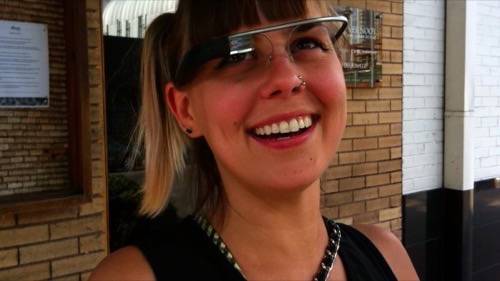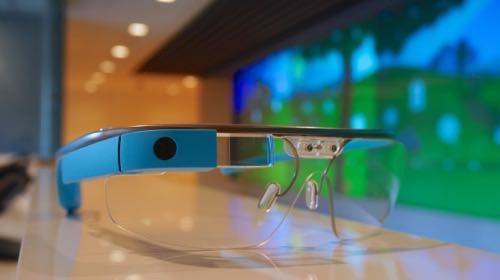The biggest hurdle in the way of potential mainstream adoption of Google Glass isn’t that it makes humans look like a crazy future cyborg race. It’s that Glass, try as it might, can’t do squat on an iPhone.
Earlier this year, I made the decision to switch back to the iPhone from Android (for this generation, anyway). And my, how I’d taken my Nexus 4’s natural rapport with Glass for granted. To clarify, Glass must be connected to a smartphone to perform many functions. Glass can get online via Bluetooth tethering to a smartphone’s 3G/4G connection. While Glass can also hop on your home Wi-Fi, for regular use it really needs to connect to an iPhone or Android smartphone.
See also: Google Glass 2.0 Is Coming—Here’s What Would Make It Incredibly Cool
But as Google Glass has been in the wild—the better part of a year now—it’s completely hamstrung if you only own an iPhone. On the Android side, Glass Explorers have access to the slick “MyGlass” app, which allows screencasting from Glass to a smartphone (awesome), offers a mobile interface for toggling Glass apps on and off (necessary) and generally provides some standard settings, since the settings menu on Glass itself is very bare bones.
You can tell where this is leading. To date, there is no iOS Glass app to speak of. Screencasting is a no-go, and if you want to manage apps and other settings, you have to visit the MyGlass portal from a web browser. Awkward.
Beyond these gripes, my two favorite features—literally the two things that make Google Glass worth the social ostracism and sky-high beta price tag— do not exist when Glass is paired with an iPhone. When using Glass paired with an iPhone you a) cannot receive text messages or b) use turn-by-turn directions.
Those are literally the two most useful things that Glass can do. The kind of things that make me want to wear it every day and integrate it into my routine for work and play both. I keep Android devices around for work too, so I’m not totally left in the cold. But plenty of folks are. So what’s the hold up?
Google’s Lame Blame Game

The obvious factors here are that, first, it’s in no way in Apple’s interest to further the nascent Google Glass platform, and second, it’s way easier to make a thoroughly Google device like Glass work well with another Google device. But there are lots of unobvious elements here, too.
Apple works with plenty of high profile developers to make apps nice and shiny for a big release, but Google is never going to be among them—no surprise there. It’s the reason Apple stalled Google Voice in the iOS App Store for well over a year, pointing to its strategically-invoked fine print, before the FCC finally got involved and Google’s voice-over-Internet app pushed through in 2010.
See also: Google Glass Can Play Music—Just Not Well, Nor For Very Long
But the MIA Glass app on iOS isn’t a casualty of an app submission stalemate. After all, the rest of Google’s apps have made it into Apple’s walled garden by now, even if they had to pull HTML5 tricks to do it. Even Google Maps, which ate Apple’s lunch in the iOS 6 era, got Apple’s greenlight with surprising ease.
The last we heard about an iOS Glass app was back in September, when Glass engineer Stephen Lau jumped into a thread on the official Glass community forum titled “What is the hangup with the iOS MyGlass app?” (here’s the link, but beware: it’s only accessible to logged-in Glass Explorers):
Hey… sorry, we can’t toss you a bone on this one. We do care about all the people using Glass, including people who have iPhones, and constantly working on improving the Glass experience. Please keep in mind that there are technical limitations on what can be done under iOS. Things like SMS & background-location-forwarding, which MyGlass/Android handles for Glass can’t be implemented under iOS.
Later in the same thread:
iOS6 supports Bluetooth MAP, which forwards text messages via Bluetooth to connected devices, but it doesn’t expose anything other than the sender’s name & contents. This means Glass can’t map the name to a contact (without string matching…) and also has no idea what phone number the person texted from, meaning you can’t reply.
New Possibilities With iOS 7
But at the time (fall 2013), iOS 7 had been in developers’ hands for months. And with iOS 7 came the Apple Notification Center Service (ANCS), an entirely new API that gives Bluetooth devices deeper access to iOS notifications. ANCS is built onto the backbone of Bluetooth LE (low energy), a technology that allows devices to remain connected for long stretches without destroying battery life.
Right now, the Pebble smartwatch is the best example of iOS 7’s new notification support. Prior to iOS 7 and Pebble’s accompanying SDK 2.0 update, my Pebble was about as useful as a rock with paired with my iPhone (it was way more feature rich on Android). Now my Pebble blinks on to forward me all kinds of notifications from my iPhone—text messages and all kinds of other minor app events.
See also: Google Glass Developers Can Finally Dive Under The Hood
Like Pebble, Google Glass blinks on when I receive a text, an email or a phone call. If I’m on Android, that is.
I spoke with Pebble developer evangelist Thomas Sarlandie on the experience of making Pebble an exemplary early wearable device with Apple’s new tools. As Sarlandie explains, “ANCS is not at all standard. What’s different with ANCS is that it’s not an iOS API. It’s really a different type of API—it’s a Bluetooth LE API.”
The notifications system could have been built on any kind of signal, but Apple is throwing its weight behind Bluetooth LE—that’s why my Pebble can stay alive for a week. “It opens tons of new possibilities,” says Sarlandie. “Especially dismissing notifications and being able to synchronize a notification you’ve seen on your Pebble with the notification that you’ve seen on your phone, so that if you see a text message… you won’t have to dismiss it again on your phone.”

One thing keeping Google Glass from that kind of deep iOS integration is the fact that Glass’s software, now in version XE11, is built on top of Android 4.0.4, which is now two versions of Android behind. Android didn’t add support for BLE until Android 4.3. Hence, Google can’t pull a Pebble with Glass. Without Bluetooth LE support, there’s no way to implement deep iOS notifications (i.e., from iMessages) on Google Glass.
On Android, everything works just fine. But making two pieces of hardware built on Android play nice with each other is easy. Making an Android device talk to an iPhone? Well, that’s a lot more complicated from the start, never mind the fact that Apple just introduced its own proprietary, BLE-dependent API for the kind of notifications that Glass is perfect for.
So, Where’s The App?
Where a Glass app for iOS is concerned—does it exist? how far along is it?—Apple is characteristically mum; the company never returned my email seeking comment. Google, generally pretty transparent in the private Glass Explorer forum and on its Google+ pages, hasn’t offered frustrated iPhone owners much information about a Glass app, either.
Presumably, Google needs to rebuild its Android-based Glass XE operating system onto Android 4.3 or higher in order to enable iOS integration and Bluetooth LE (the latter of which, among other things, could help improve Glass’ truly atrocious battery life). If that work is underway, though, Google hasn’t given any sign of it.
For once in the storied tale of Google vs. Apple, the ball isn’t in Apple’s court. If Google has delivered on the design promise of our wearable future, and I’d argue that it has, it’s high time to bring the software up to speed. With ANCS and the M7 processor, Apple is clearly dead serious about wearable devices.
Still, beyond the iPhone 5S’s M7 motion co-processor, Apple has yet to show its hand. Google’s black ops wearable began as a moonshot, but considering its polish and its buzz, it just might be crazy enough to take off.
But leaving iPhone users out in the cold? That’s no way to start a revolution.
Lead image via Flickr user tedeytan, CC 2.0. Other images via Flickr users tedeytan and jessica mullen










